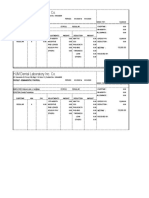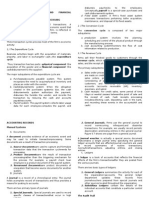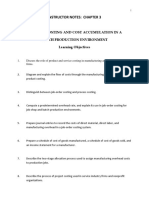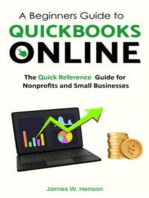Activity 8 - Transaction Processing and Financial Reporting
Uploaded by
Daiane AlcaideActivity 8 - Transaction Processing and Financial Reporting
Uploaded by
Daiane AlcaideTransaction Processing and Financial Reporting
ACTIVITY No. 8
I. Transaction Cycle Identification
Categorize each of the following activities into the expenditure, conversion, or revenue cycles and
identify the applicable subsystem.
a. preparing the weekly payroll for manufacturing personnel
b. releasing raw materials for use in the manufacturing cycle
c. recording the receipt of payment for goods sold
d. recording the order placed by a customer
e. ordering raw materials
f. determining the amount of raw materials to order
II. Types of Files
For each of the following records, indicate the appropriate related file structure: master file, transaction
file, reference file, or archive file.
a. customer ledgers
b. purchase orders
c. list of authorized vendors
d. records related to prior pay periods
e. vendor ledgers
f. hours each employee has worked during the current pay period
g. tax tables
h. sales orders that have been processed and recorded
III. Internal Control
Leslie Epstein, an employee of Bormack Manufacturing Company, prepares journal vouchers for
general ledger entries. Because of the large number of voided journal vouchers caused by errors, the
journal vouchers are not prenumbered by the printer; rather, Leslie numbers them as she prepares
each journal voucher. She does, however, keep a log of all journal vouchers written so that she does
not assign the same number to two journal vouchers. Bi weekly, Leslie posts the journal vouchers to
the general led ger and any necessary subsidiary accounts. Bimonthly, she reconciles the subsidiary
accounts to their control accounts in the general ledger and makes sure the general ledger accounts
balance.
Required: Discuss any potential control weaknesses and problems in this scenario.
IV. System Documentation - Payroll
The following describes the payroll procedures for a hypothetical company. Every Thursday, the
timekeeping clerk sends employee time cards to the payroll department for processing. Based on the
hours worked reflected on the time cards, the employee pay rate and withholding information in the
employee file, and the tax rate reference file, the payroll clerk calculates gross pay, withholdings, and
net pay for each employee. The clerk then manually prepares paychecks for each employee, files hard
copies of the pay checks in the payroll department, and posts the earnings to the hard-copy employee
records.
Finally, the clerk manually prepares a payroll summary and sends it and the paychecks to the cash
disbursements department. The cash disbursements clerk reconciles the payroll summary with the
paychecks and manually records the transaction in the hard-copy cash disbursements journal. The
clerk then files the payroll summary and sends the paychecks to the treasurer for signing. The signed
checks are then sent to the pay master, who distributes them to the employees on Friday morning.
Required: Prepare a data flow diagram and a system flowchart of the payroll procedures previously
described.
V. Multiple Choice
1. Which statement is not true?
a. Business activities begin with the acquisition of materials, property, and labor in exchange for cash.
b. The conversion cycle includes the task of determining raw materials requirements.
c. Manufacturing firms have a conversion cycle but retail firms do not.
Transaction Processing and Financial Reporting
ACTIVITY No. 8
d. A payroll check is an example of a product document of the payroll system.
e. A journal voucher is actually a special source document.
2. A documentation tool that depicts the physical flow of information relating to a particular trans action
through an organization is a
a. system flowchart.
b. program flowchart.
c. decision table.
d. work distribution analysis.
e. systems survey.
3. Sequential file processing will not permit
a. data to be edited on a separate computer run.
b. the use of a database structure.
c. data to be edited in an offline mode.
d. batch processing to be initiated from a terminal.
e. data to be edited on a real-time basis.
4. The production subsystem of the conversion cycle includes all of the following EXCEPT
a. determining raw materials requirements.
b. make or buy decisions on component parts.
c. release of raw materials into production.
d. scheduling the goods to be produced.
5. Which of the following files is a temporary file?
a. transaction file
b. master file
c. reference file
d. none of the above
You might also like
- HJM Dental Laboratory Inc. Co-Payslip-Template-with-calculatorNo ratings yetHJM Dental Laboratory Inc. Co-Payslip-Template-with-calculator3 pages
- Net Pay: Innovative Retail Concepts Private LimitedNo ratings yetNet Pay: Innovative Retail Concepts Private Limited3 pages
- Catibog-Activity 8-Transaction Processing and Financial ReportingNo ratings yetCatibog-Activity 8-Transaction Processing and Financial Reporting4 pages
- Accounting Information System Naod Chapter TwoNo ratings yetAccounting Information System Naod Chapter Two10 pages
- Tutorial 2 Chapter2 Foundational Concepts of The AisNo ratings yetTutorial 2 Chapter2 Foundational Concepts of The Ais10 pages
- Castro, Mae Lalaine B. (Chapter 2 Assignment)No ratings yetCastro, Mae Lalaine B. (Chapter 2 Assignment)3 pages
- Chapter 2_Introduction to Transaction ProcessingNo ratings yetChapter 2_Introduction to Transaction Processing11 pages
- Managerial Accounting Version 2 1st Edition Heisinger Test BankNo ratings yetManagerial Accounting Version 2 1st Edition Heisinger Test Bank30 pages
- Required: Create A Data Flow Diagram of The Current System0% (1)Required: Create A Data Flow Diagram of The Current System2 pages
- MODULE 10 MULTIPLE CHOICE QUESTIONS (To Be Answered As A Test) - Highlight Your Answer inNo ratings yetMODULE 10 MULTIPLE CHOICE QUESTIONS (To Be Answered As A Test) - Highlight Your Answer in3 pages
- At.3512 - Specific Audit Procedures (Part 2)No ratings yetAt.3512 - Specific Audit Procedures (Part 2)4 pages
- Chapter 6 Accounting Information SystemNo ratings yetChapter 6 Accounting Information System11 pages
- Survey of Accounting 7th Edition Warren Solutions Manual - Download Now And Never Miss A Chapter100% (4)Survey of Accounting 7th Edition Warren Solutions Manual - Download Now And Never Miss A Chapter56 pages
- Accounting-Process - 20231118 005115 0000No ratings yetAccounting-Process - 20231118 005115 000027 pages
- Accounting Information System Seatwork 1No ratings yetAccounting Information System Seatwork 16 pages
- Accounting Information System I SEMESTER I 2010/2011: Group AssignmentNo ratings yetAccounting Information System I SEMESTER I 2010/2011: Group Assignment9 pages
- Accounting Information Systems 9th Edition Hall Solutions Manual - PDF Version Is Available For Instant Access100% (3)Accounting Information Systems 9th Edition Hall Solutions Manual - PDF Version Is Available For Instant Access46 pages
- Intermediate Accounting Stice 19th Edition Solutions Manual - Download Instantly To Experience The Full Content100% (11)Intermediate Accounting Stice 19th Edition Solutions Manual - Download Instantly To Experience The Full Content28 pages
- MODULE 01 Transaction Processes and Business ProcessesNo ratings yetMODULE 01 Transaction Processes and Business Processes6 pages
- Purchasing, Inventory, and Cash Disbursements: Common Frauds and Internal ControlsFrom EverandPurchasing, Inventory, and Cash Disbursements: Common Frauds and Internal Controls4.5/5 (3)
- A Beginners Guide to QuickBooks Online: The Quick Reference Guide for Nonprofits and Small BusinessesFrom EverandA Beginners Guide to QuickBooks Online: The Quick Reference Guide for Nonprofits and Small BusinessesNo ratings yet
- Concentrix Services India Private Limited Payslip For The Month of Oct - 2023No ratings yetConcentrix Services India Private Limited Payslip For The Month of Oct - 20231 page
- Pan HR Solution PVT LTD.: Plot No.9, Sector-4, Vaishali, Ghaziabad (U.P.) 201010No ratings yetPan HR Solution PVT LTD.: Plot No.9, Sector-4, Vaishali, Ghaziabad (U.P.) 2010101 page
- Carmela H. Bersonda - 20231209 - 212700 - 0000No ratings yetCarmela H. Bersonda - 20231209 - 212700 - 00006 pages
- Everyone Can Belong: Questions? We Want To Hear From YouNo ratings yetEveryone Can Belong: Questions? We Want To Hear From You2 pages
- List Four Control Objectives of Sales SystemNo ratings yetList Four Control Objectives of Sales System4 pages
- Official Payslip: Department of EducationNo ratings yetOfficial Payslip: Department of Education1 page
- Training Guide For Oracle EBS R12 Self ServiceNo ratings yetTraining Guide For Oracle EBS R12 Self Service41 pages
- ESR-NHS0340-Payroll Processing Guide v2.0No ratings yetESR-NHS0340-Payroll Processing Guide v2.026 pages
- My Payroll Exam Questions 2022-1050-IZ0 (2) (1)-1No ratings yetMy Payroll Exam Questions 2022-1050-IZ0 (2) (1)-121 pages
- MO 07 Preparing, Matching and Process RecieptNo ratings yetMO 07 Preparing, Matching and Process Reciept68 pages
- FAQ's of Allsec App Usage - Do's & Dont'sNo ratings yetFAQ's of Allsec App Usage - Do's & Dont's2 pages
- Payroll Management System Literature Review100% (1)Payroll Management System Literature Review5 pages
- Chapter 5 Internal Control Payroll CycleNo ratings yetChapter 5 Internal Control Payroll Cycle103 pages
- How To Create A Dave Ramsey Budget in Quicken100% (5)How To Create A Dave Ramsey Budget in Quicken14 pages

























































































